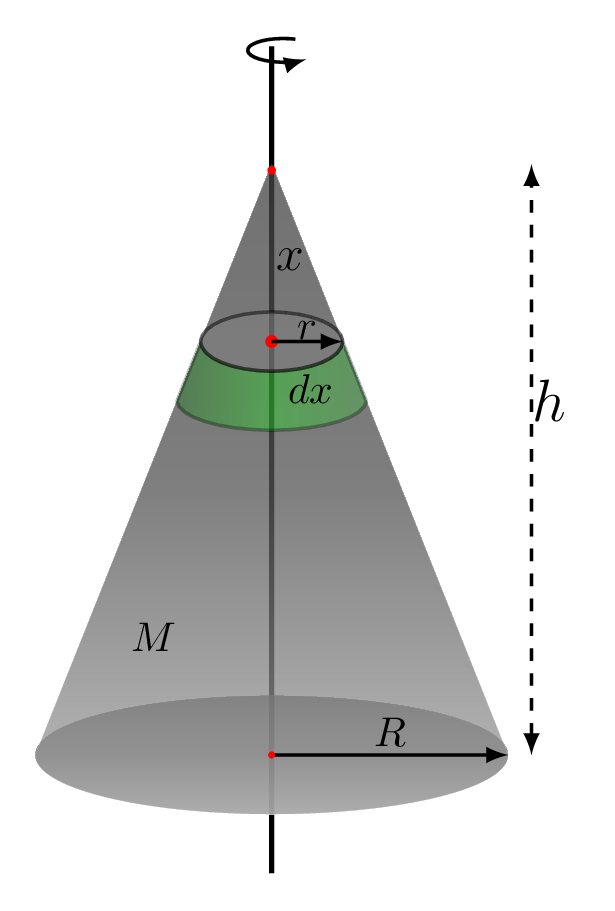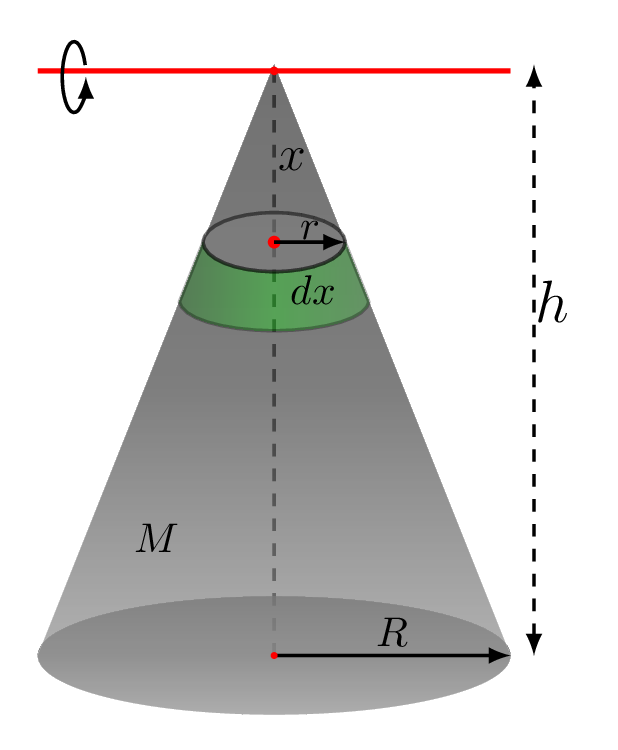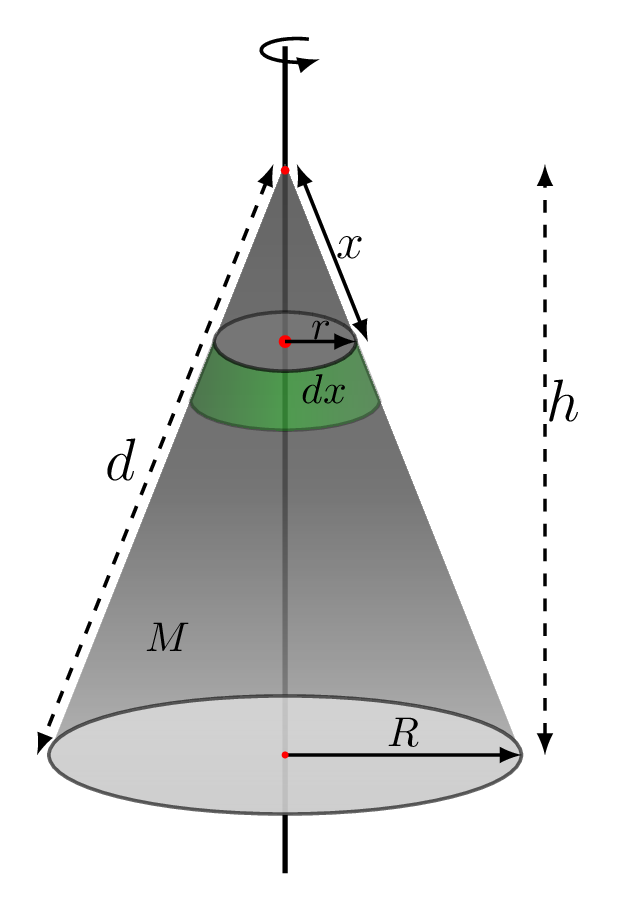Subsection 7.1.8 Moment of Inertia of a Cone



Subsubsection 7.1.8.1 Moment of Inertia of a Solid Cone about an axis of symmetry
Consider a concentric disk of radius \(r\) and thickness \(\,dx\) at a distance \(x\) from the vertex in a solid cone of mass \(M\) and radius \(R\) [Figure 7.1.11.(a)], then the moment of inertia of this disk about its center of mass can be given as
\begin{equation*}
\,dI=\frac{1}{2}\,dm\,r^{2} = \frac{1}{2}\left[\frac{M}{\frac{1}{3}\pi R^{2}h}\right]\left(\pi r^{2}\,dx\right)r^{2}
\end{equation*}
\begin{equation*}
\text{or,}\quad I = \left(\frac{3M}{2\pi R^{2}h}\right) \int\limits_{0}^{h}\left(\pi r^{4}\right)\,dx
\end{equation*}
\begin{equation*}
= \left(\frac{3M}{2R^{2}h}\right) \int\limits_{0}^{h}\left(\frac{x^{4}R^{4}}{h^{4}}\right)\,dx
\end{equation*}
\begin{equation*}
[\because \frac{x}{h}=\frac{r}{R}\quad \text{from similar triangles in figure}]
\end{equation*}
\begin{equation*}
\text{or,}\quad I = \left(\frac{3M}{2h^{5}}\right) \int\limits_{0}^{h}\left(x^{4}R^{2}\right)\,dx
\end{equation*}
\begin{equation*}
= \left(\frac{3MR^{2}}{2h^{5}}\right) \left(\frac{x^{5}}{5}\right)_{0}^{h}
\end{equation*}
\begin{equation*}
\therefore\quad I = \left(\frac{3MR^{2}}{2h^{5}}\right) \left(\frac{h^{5}}{5}\right)= \frac{3}{10}MR^{2}
\end{equation*}
Subsubsection 7.1.8.2 Moment of Inertia of a Solid Cone about a Vertex Parallel to the Base
Consider a concentric disk of radius \(r\) and thickness \(\,dx\) at a distance \(x\) from the vertex in a solid cone of mass \(M\) and radius \(R\) [Figure 7.1.11.(b)], then the moment of inertia of this disk about its diameter can be given as
\begin{equation*}
\,dI_{cm}=\frac{1}{4}\,dm\,r^{2}
\end{equation*}
\begin{equation*}
= \frac{1}{4}\left[\frac{M}{\frac{1}{3}\pi R^{2}h}\right]\left(\pi r^{2}\,dx\right)r^{2}
\end{equation*}
\begin{equation*}
\text{or,}\quad \,dI_{cm} = \left(\frac{3M}{4 R^{2}h}\right) \left(r^{4}\right)\,dx
\end{equation*}
\begin{equation*}
= \left(\frac{3M}{4R^{2}h}\right) \left(\frac{x^{4}R^{4}}{h^{4}}\right)\,dx
\end{equation*}
\begin{equation*}
[\because \frac{x}{h}=\frac{r}{R}\quad \text{from similar triangles in figure}]
\end{equation*}
\begin{equation*}
\text{or,}\quad \,dI_{cm} = \left(\frac{3MR^{2}}{4h^{5}}\right) \left(x^{4}\right)\,dx
\end{equation*}
Moment of inertia of this disk about the vertex of the cone can be
\begin{equation*}
\,dI_{vert}=\,dI_{cm}+\,dm x^{2}
\end{equation*}
\begin{equation*}
= \left(\frac{3MR^{2}}{4h^{5}}\right) \left(x^{4}\right)\,dx + \left[\frac{M}{\frac{1}{3}\pi R^{2}h}\right]\left(\pi r^{2}\,dx\right) x^{2}
\end{equation*}
\begin{equation*}
= \left(\frac{3MR^{2}}{4h^{5}}\right) \left(x^{4}\right)\,dx + \left(\frac{3M}{R^{2}h}\right) r^{2}x^{2} \,dx
\end{equation*}
\begin{equation*}
= \left(\frac{3MR^{2}}{4h^{5}}\right) \left(x^{4}\right)\,dx + \left(\frac{3M}{R^{2}h}\right) \left(\frac{x^{2}R^{2}}{h^{2}}\right)x^{2} \,dx
\end{equation*}
Hence moment of inertia of a solid cone about its vertex is given by
\begin{equation*}
I_{vert}=\int\,dI_{vert}
\end{equation*}
\begin{equation*}
= \left[\left(\frac{3MR^{2}}{4h^{5}}\right) +\left(\frac{3M}{h^{3}}\right)\right]\int\limits_{0}^{h}\left(x^{4}\right)\,dx
\end{equation*}
\begin{equation*}
=\frac{3M}{5}\left(\frac{R^{4}}{4}+h^{2}\right)
\end{equation*}
Subsubsection 7.1.8.3 Moment of Inertia of a Hollow Cone about an axis of symmetry
Consider an elemetary ring of radius \(r\) and thickness \(\,dx\) at a slanted distance \(x\) from the vertex in a hollow cone of mass \(M\) and radius \(R\) [Figure 7.1.11.(c)], then the moment of inertia of this ring about its center of mass can be given as
\begin{equation*}
\,dI=\,dm\,r^{2} = \left[\frac{M}{\pi R d}\right]\left(2\pi r\,dx\right)r^{2}
\end{equation*}
\begin{equation*}
\text{or,}\quad I = \left[\frac{2M}{R d}\right] \int\limits_{0}^{d}r^{3}\,dx
\end{equation*}
\begin{equation*}
= \left[\frac{2M}{R d}\right] \int\limits_{0}^{d}\left(\frac{xR}{d}\right)^{3}\,dx
\end{equation*}
\begin{equation*}
[\because \frac{x}{d}=\frac{r}{R}\quad \text{from similar triangles in figure}]
\end{equation*}
\begin{equation*}
\text{or,}\quad I = \left[\frac{2MR^{2}}{d^{4}}\right]\int\limits_{0}^{d} x^{3}\,dx
\end{equation*}
\begin{equation*}
= \left[\frac{2MR^{2}}{d^{4}}\right] \left(\frac{x^{4}}{4}\right)_{0}^{d}
\end{equation*}
\begin{equation*}
\therefore\quad I = \left[\frac{MR^{2}}{2d^{4}}\right] d^{4} = \frac{1}{2}MR^{2}
\end{equation*}
